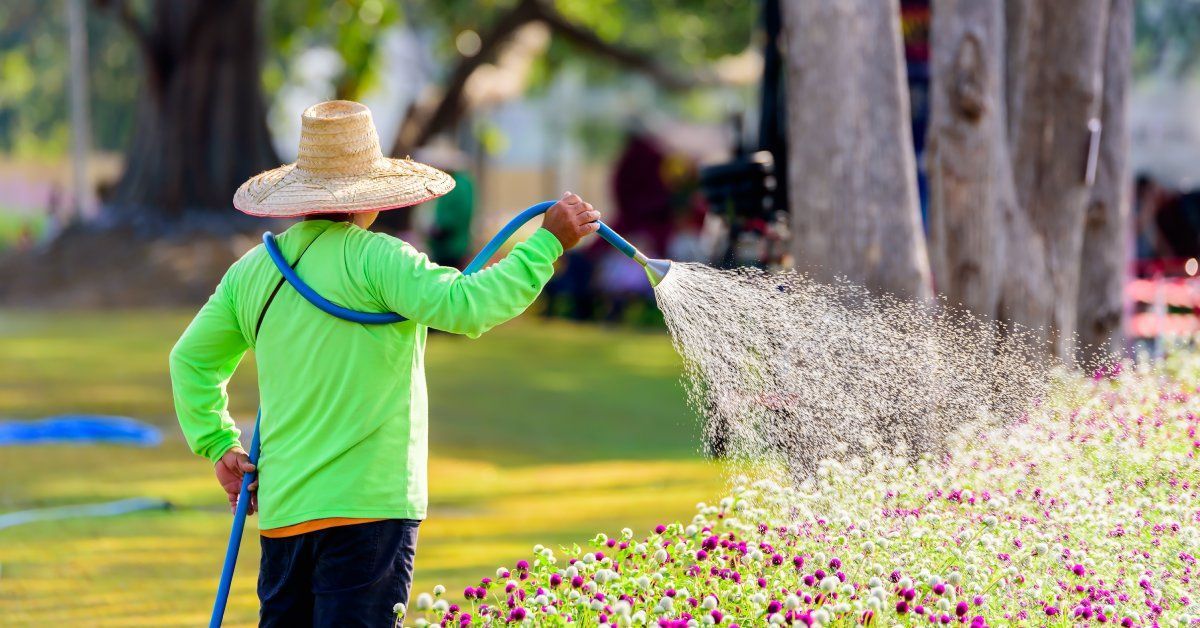Healthcare Facilities: Landscape Maintenance Requirements

Create a welcoming and safe environment for your health-care facility by learning how to maintain its landscaping. Patients, visitors, and staff rely on these spaces for navigation, relaxation, and therapeutic purposes. Effective landscape maintenance supports functionality, safety, and aesthetics. Let’s go into detail on some of the common landscape maintenance requirements for health-care facilities .
Safety and Accessibility
Safety and accessibility form the foundation of landscape maintenance in health-care facilities. Outdoor spaces must remain free from hazards and accessible to individuals with varying mobility needs. Neglecting safety and accessibility can lead to accidents or violations of regulatory standards.
Pathway and Surface Maintenance
Pathways facilitate the safe movement of individuals throughout a health-care facility’s outdoor spaces. Cracks, uneven surfaces, or debris on walkways can pose risks to patients, visitors, and staff. Regular inspections identify potential hazards early, allowing teams to take corrective action, such as repairing cracks, leveling uneven surfaces, or clearing debris.
Compliance with the Americans with Disabilities Act (ADA) is essential for health-care facility pathways. Pathways must accommodate wheelchairs and other mobility aids, requiring features such as ramps, tactile warnings near edges, and smooth transitions between surfaces.
Maintaining standards prevents accidents and ensures inclusivity for all users. Consistent attention enhances everyone’s overall safety, contributing to a positive experience for everyone at the facility.
Allstate Landscape Services provides you with solutions to help you effectively meet landscape maintenance requirements for health-care facilities. Investing in professional landscaping enhances the environment for patients, staff, and visitors alike.
Clear Visibility and Lighting
Clear visibility and adequate lighting enhance safety and comfort across outdoor areas. Overgrown vegetation, including trees and shrubs near walkways, can obstruct sightlines and create hidden hazards. Landscaping teams routinely trim and shape plants to maintain open views and reduce risks in high-traffic zones, such as entrances and pathways.
Lighting is equally important, particularly during evening hours or in shaded areas. Strategically placed light fixtures illuminate pathways, parking areas, and entrances to reduce slips and trips. Energy-efficient options, such as LED lights and solar-powered fixtures, support sustainability while providing reliable illumination. Health-care facilities that prioritize clear visibility and lighting meet one of the main landscape maintenance requirements for health-care facilities while creating a secure outdoor environment.
Hygiene and Pest Control

Maintaining cleanliness and preventing pest infestations are essential aspects of health-care facility landscaping. A hygienic environment promotes patient well-being and reduces health risks associated with pests or decaying organic material.
Waste Management and Cleanliness
Proper waste management begins with the regular removal of fallen leaves, litter, and other debris. Unattended materials can accumulate in walkways, gardens, and drainage systems, leading to unsanitary conditions. Maintenance teams must schedule routine cleanups to preserve the visual appeal of outdoor spaces while preventing hazards such as slippery surfaces or blocked drains.
Regularly inspecting stormwater drainage systems is also important for maintaining cleanliness. Debris and sediment can clog systems, causing water to pool and create breeding grounds for mosquitoes.
Integrated Pest Management (IPM)
Pest infestations can compromise the health and safety of outdoor spaces in health-care facilities. Integrated Pest Management (IPM) offers a proactive and eco-friendly approach to pest control, minimizing the use of harmful chemicals. Teams can use preventative strategies, such as sealing gaps near building exteriors, planting pest-resistant vegetation, and maintaining clean outdoor areas to deter pests.
Routine inspections help crews identify early signs of infestations, such as chewed leaves or burrow holes. Landscaping teams can deploy targeted treatments when necessary, including biological controls or organic repellents, to effectively address pest issues. Teams use preventative strategies, such as sealing gaps near building exteriors, planting pest-resistant vegetation, and maintaining clean outdoor areas to deter pests.
Aesthetic and Therapeutic Landscaping
Aesthetic and therapeutic landscaping significantly contribute to the patient experience and the facility’s image. Outdoor spaces support relaxation, healing, and emotional well-being.
Garden and Green Space Maintenance
Gardens and green spaces within health-care facilities serve as tranquil environments for patients and visitors. Regular maintenance, including pruning, weeding, and mulching, preserves the beauty and functionality of areas. Seasonal planting adds vibrant colors and fresh blooms, ensuring that gardens remain inviting year-round.
Health-care facilities often feature therapeutic gardens designed to promote relaxation and mental well-being. Garden spaces require specialized attention, such as maintaining walking paths, cleaning water features, and selecting plants suited to local climates.
Enhancing Visual Harmony
Landscaping teams focus on creating visually cohesive outdoor spaces that align with the health-care facility’s professional image. Pruning trees and shrubs promotes clean lines while maintaining proper spacing between plants, encouraging healthy growth and preventing overcrowding.
Incorporating design elements, such as layered planting and uniform edging, enhances visual appeal. Landscaping teams also pay attention to the condition of hardscape elements, such as retaining walls, benches, and planters, repairing or replacing them as needed.
Environmental Sustainability

Environmental sustainability represents a growing focus for health-care landscaping. Facilities adopting eco-friendly practices protect the environment while maintaining functional and attractive outdoor spaces.
Water Conservation
Efficient water use remains a key goal for sustainable landscaping. Drip irrigation systems and rainwater harvesting reduce water consumption while maintaining healthy plant growth. Selecting drought-tolerant or native plants further decreases reliance on supplemental irrigation, especially in regions prone to water scarcity.
Regular irrigation system maintenance should include checking for leaks and calibrating timers to ensure optimal performance. Integrating water-saving measures into their landscaping strategies helps health-care facilities effectively address cost and environmental concerns.
Soil and Plant Health
Healthy soil and plants form the backbone of successful landscaping. Routine soil testing identifies nutrient deficiencies, guiding the application of fertilizers or organic amendments. Composting offers an eco-friendly way to enrich soil while recycling organic waste generated during maintenance.
Landscaping teams also focus on plant health, promptly removing diseased or dead vegetation to prevent the spread of infections. Plant selection emphasizes species suited to the local climate, promoting resilience and reducing the need for intensive care.
Compliance With Health-Care Standards
Health-care facilities must meet stringent landscaping standards to support safety, hygiene, and emergency protocols. Regular inspections help landscaping teams identify hazards such as uneven pathways, overgrown vegetation, and faulty lighting. Accurate documentation, including maintenance logs and pest control records, ensures compliance and aids in audits.
Infection control measures are also vital, as are practices such as cleaning outdoor seating, maintaining water features, and using low-allergen plants. Landscaping teams must also prioritize creating and maintaining clear emergency access by keeping evacuation routes free from obstructions and well-lit.
Regular Inspections and Documentation
Scheduled inspections allow teams to identify and address potential issues before they escalate. Comprehensive documentation of maintenance activities supports compliance with regulatory requirements, offering valuable records for audits or certifications.
Facilities that work with professionals benefit from tailored solutions that address their specific challenges. Allstate Landscape Services offers commercial garden maintenance services designed to help health-care facilities meet industry standards while maintaining visually appealing and functional spaces.
Adherence to Safety Protocols
Landscaping professionals understand a health-care environment’s unique demands, from infection control to emergency access. Landscaping teams meticulously follow safety protocols, reducing risks associated with outdoor spaces.
Health-care facilities depend on well-maintained landscapes to support safety, aesthetics, and therapeutic value. Professional landscaping services address key needs, from pest control to sustainable practices.
